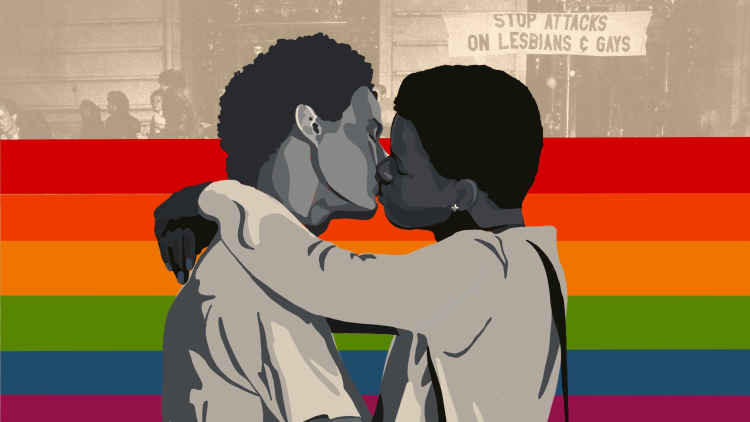

LGBT+ History Month takes place every February in the UK, and its overall aim is to promote equality and diversity. It does this by increasing the visibility of lesbian, gay, bisexual and transgender (LGBT+) people, including their lives, experiences and history, and by raising awareness and advancing education on areas affecting the LGBT+ community. Started in 2005, this event celebrates LGBT+ icons of the past and present, giving young LGBT+ people the chance to discover role models that have been underrepresented in history and the media.
In celebration, and in keeping with the month’s theme of ‘Politics In Art’, first year student, Emma Taylor, has created an amazing piece of artwork which is featured above. Emma commented, “The Stonewall demonstrations in 1969 were sparked in response to police brutality and intolerance towards the LGBT+ community following a raid on the Stonewall Inn; a local gay club in New York. ‘The first Pride was a riot’ is a saying that you’re likely to see and hear during Pride month. However, I didn’t want to make the riots, that have been synonymous with Stonewall since the ‘60s, the focus of the piece. Behind the anger and explosive revolt, every participant in 1969 wanted to love freely, and be freely loved in return. At the same time the police were beating protesters to the ground, two men held each other close in a quiet spot in the neighbourhood, free at that moment to love one another entirely. When I am asked about who I am as a member of the LGBT+ community, it is not discrimination or hate that defines me. It is love.”
To celebrate the start of the month-long celebrations, we wanted to share the stories of some LGBT+ icons that mean a lot to us, and have helped us feel more comfortable with our identities. Click on the boxes below to read more.
Keith Haring (1958-1990) was an inspirational, openly gay pop artist. His unique style and disregard for the expectations of what art should be has led to his name still being known today as synonymous with street art. Being a gay man in the ‘80s and ‘90s, Haring was heavily exposed to the fear, misinformation and homophobia surrounding the AIDS epidemic. To combat this, Haring utilised his art skills to bring awareness and spread facts about the truth of AIDS to everyone.
Before his death from AIDS-related complications in 1990, Haring established the ‘Keith Haring Foundation’ to provide funding for AIDS organisations and children’s programmes. This foundation continues to outlive him, educating the public on HIV and AIDS. Haring’s defiant individuality and courage during one of the community’s most challenging events in history are why we are drawn to him as one of our LGBT+ role-models.
Mark Aguhar (1987-2012) was a transfeminine Filipino activist and artist, known for her radical multimedia art. Her artistic creations celebrated existing outside of expectations and brought attention to her experience as a “queer, trans, fat, femme, and brown” person in the LGBT+ community. When representing the LGBT+ community, the media has notoriously favoured the stereotypical ‘gay white male body’, which has left many members of the community who do not fit this, feeling underrepresented and invalid.
Her work questioned why this portrayal has been glorified and appreciated the existence of people like her who are not represented by it. Aguhar’s confidence to persist with self-love and her outspoken appreciation for those feeling unrepresented has cemented her legacy as a truly remarkable LGBT+ figure.
Elliot Page (1987-) is a Canadian actor, most recently known for his role as Vanya Hargreeves in the Netflix show ‘The Umbrella Academy.’
In December 2020, Page came out as transgender non-binary on social media. In their coming-out post, they recognized how much of an impact they were making by doing so, and decided to present their post as a simultaneous declaration of self-love, a call-out on political transphobia, and an acknowledgement of other trans people.
The decision to continue to embrace the female role of Vanya Hargreeves, and to choose personal preference over expectations of dropping the role due to his masculine-aligned identity, expresses the possibilities of gender to both trans and cis people. Gender is not defined by surface-level perceptions such as someone’s appearance or how someone acts or who they act as. As someone who remains active and supportive in the LGBT+ community today, Page stands as one of the most admired living trans role models for both young and old in the community.
Being able to look at the lives and experiences of fellow LGBT+ people is vital. Learning about the successes of those like us shows us that, despite some of the hard experiences that come with being LGBT+, joy as our authentic selves is possible. With more and more allies becoming aware of LGBT+ issues, safe spaces like the Gender and Sexuality Alliance (GSA) at the College, where student members feel that their identities will always be accepted, are important to ensure a bright, loving and accepting future for the community. Looking back at these historic icons gives us a chance to appreciate their achievements, fuelling us with inspiration to move forward to continue their positive influences.
So, to the rest of the LGBT+ community and our allies, have a great month!
Article written by first year student, James Turrell